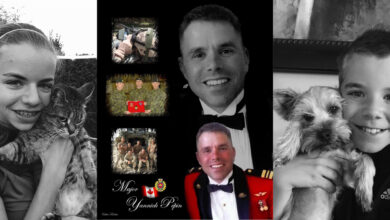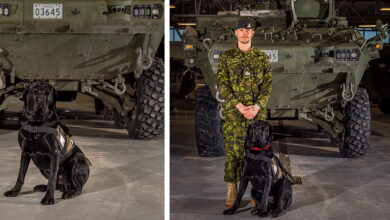Best of CMF Magazine
The Poppy Fund
Since 1922, poppies have found a home on the left lapels of Canadians from the last Friday of October through November 11. Serving as a symbol of remembrance for fallen Canadians, today the poppy is worn with pride by nearly half of all Canadians.
Its significance finds its roots before the First World War with records of the incredible growth of poppies in Flanders, France across the graves of soldiers in the 19th Century. Following the publication of Lieutenant Colonel John McCrae’s poem – In Flanders Fields – the poppy further grew as a symbol of remembrance for the fallen.
As a long-established tradition, there is an existing protocol for sporting a poppy. It should be worn on the left lapel without any additional pins. Starting with the 2013 campaign, the Legion is offering a simple clear plastic disc called a poppy keeper to help secure elusive poppies to clothing. Although the distribution may not be Canada-wide with this campaign, they will be present at many outlets. Metal pins featuring a poppy and banner are also available from the legion as an alternative to the traditional poppy.
In 2012, the Royal Canadian Legion’s Poppy Campaign raised 14 million dollars through the distribution of 19 million poppies. The funds raised are placed in each branch’s Poppy Fund, which is a trust fund reserved for assisting veterans and the community at large.
Although the Poppy Fund is not reserved for donations to other charities, the poppy fund supports several initiatives at the local and national level. Included in the list of causes supported by Poppy Funds are bursaries, scholarships, and monument preservations and restoration. The fund can also be used for special projects for veterans, wheelchair accessibility modifications, and training and research. If the recipients aren’t a veteran or an organization directly related to the service of Canadian and Commonwealth veterans, the organization must be one that provides service to local veterans and their families.
Although the policies surrounding Poppy Fund dollars have remained the same, Bill Maxwell of the Royal Canadian Legion, says its uses have shifted with the new generation of veterans. The qualifications for support are the same, however, the recipients, programs, and projects supporting today’s veterans are a little different from their predecessors. With the evolution of veterans, Poppy Funds have also evolved.
The majority of the funds collected are from the autumn poppy campaign, which is led by volunteers. Volunteers are seen at several outlets distributing poppies and many more are responsible for the organization and the distribution of poppies throughout the country. Poppies are also shipped to Canadian embassies, groups, and corporations outside of the country.
Those interested in volunteering for their local campaign should contact their local branch.
For further information regarding the Poppy Fund or to find your local Branch, visit www.legion.ca.









